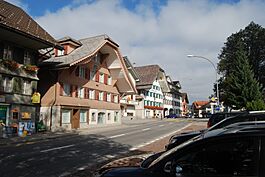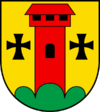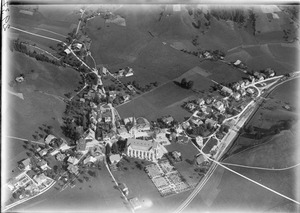Escholzmatt facts for kids
Quick facts for kids
Escholzmatt
|
||
|---|---|---|
 |
||
|
||
| Country | Switzerland | |
| Canton | Lucerne | |
| District | Entlebuch | |
| Area | ||
| • Total | 61.29 km2 (23.66 sq mi) | |
| Elevation | 852 m (2,795 ft) | |
| Population
(Dec 2011)
|
||
| • Total | 3,138 | |
| • Density | 51.199/km2 (132.61/sq mi) | |
| Postal code |
6182
|
|
| Surrounded by | Flühli, Marbach, Romoos, Schüpfheim, Trub (BE) | |
Escholzmatt was once a town in the canton of Lucerne in Switzerland. It was located in the Entlebuch district. Escholzmatt was the second largest town in its canton based on its size. It has been part of the UNESCO Entlebuch Biosphere Reserve since 2001. This means the area is special for its nature and culture. On January 1, 2013, Escholzmatt joined with another town, Marbach. Together, they formed a new town called Escholzmatt-Marbach.
Contents
History of Escholzmatt
Escholzmatt is a very old place. It was first written about in the year 1160. Back then, it was called Askolvismatte. Later, around 1240, people also called it Askoltispach and Asholtismate. By 1275, its name was recorded as Aeschelsmat.
Geography of Escholzmatt
Escholzmatt covered an area of about 61.3 square kilometers (about 23.7 square miles). A large part of this land, about half, was used for farming. Almost as much, about 44%, was covered by forests. A smaller part, about 3%, had buildings and roads. The rest of the land included rivers or other natural areas.
This former town is located on a watershed. This means it's a high point where water flows in different directions. Water from Escholzmatt flows into either the Grosse Emme or the Kleine Emme rivers. The lowest point in the town was about 753 meters (2,470 feet) above sea level. The highest point was about 2,090 meters (6,857 feet) on the Schrattenfluh mountain. Besides the main village of Escholzmatt, there were also smaller communities. These included the hamlets of Lehn, Feldmoos, Wiggen, and Dürrenbach.
People of Escholzmatt
In 2011, Escholzmatt had a population of 3,138 people. A small part of the population, about 5.7%, were people from other countries. Over ten years, the number of people living there went down a little. Most people in Escholzmatt speak German, which is about 95% of the population. Other languages spoken include Albanian and Serbo-Croatian.
In 2007, people voted in an election. The most popular political group was the CVP. They received almost half of the votes. Other popular groups were the SVP and the FDP.
Many young people lived in Escholzmatt. About 26% of the population was under 20 years old. About 25% were young adults between 20 and 39. Most people in Switzerland get a good education. In Escholzmatt, more than half of the adults had finished high school or gone to college.
Most homes in Escholzmatt were for single families or two families. There were also some larger buildings with many apartments. Many people worked in different jobs. Some worked in farming, which is called the primary sector. Others worked in factories or making things, which is the secondary sector. Many also worked in services, like shops or offices. This is called the tertiary sector.
Most people in Escholzmatt were Roman Catholic, about 78%. About 11% were Protestant. A small number of people followed other Christian faiths or were Muslim. Some people did not belong to any organized religion.
Here is a table showing how the population of Escholzmatt changed over time:
| year | population |
|---|---|
| 1650 | about 900 |
| 1850 | 3,348 |
| 1900 | 3,127 |
| 1950 | 3,509 |
| 2000 | 3,229 |
Weather in Escholzmatt
Escholzmatt usually has about 153 days of rain each year. On average, it gets about 1,424 millimeters (56 inches) of rain. June is often the wettest month, with about 172 millimeters (6.8 inches) of rain. It rains for about 15 days in June. May has the most rainy days, about 15.5 days, but with a bit less rain than June. February is the driest month, getting about 85 millimeters (3.3 inches) of rain.
See also
 In Spanish: Escholzmatt para niños
In Spanish: Escholzmatt para niños





